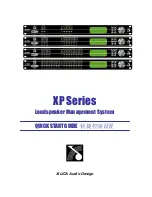
BREAK-IN
The CS2.7s, like most speakers, require a period of playing before they perform optimally. The time
required depends on how loudly the speakers are played; more time is required if played softly, less if
played loudly. At least 200 hours at moderately loud levels are required before the speaker is performing
near optimum. You should notice even more improvement after 300-400 hours of playing.
ASSOCIATED EQUIPMENT
The CS2.7s are very high quality sound reproducers and will benefit from use with the finest associated
equipment. Because the CS2.7 is a 4 ohm speaker, an amplifier with high current capability is
recommended. It is desirable that the amplifier provide twice the power into a 4 ohm load as into an 8
ohm load. Since the CS2.7s are extremely accurate transducers, they will reveal distortions generated
anywhere in the system. Also, the quality of the interconnect and speaker cables will significantly affect
the performance of the system.
POWER REQUIREMENTS
It is important to have enough power to play at the level you desire without distortion. If you play
the speakers more loudly than the volume the amplifier can cleanly produce, the amplifier will
produce overload (clipping) distortion. The sound will become compressed, strained, and in extreme
cases, obviously distorted. This distortion is actually non-musical additional energy, and since it is
concentrated in the high frequency region where the speaker is least able to handle it, tweeters can be
damaged in extreme cases. If high sound levels are desired, the CS2.7’s are designed to be used with
amplifiers rated up to 600 watts per channel.
Keep in mind that sound quality is usually more important than sound quantity. There can be large
differences in the sonic performance of two amplifiers of equal power, and this is more important
than large differences in power. Most everyone will be happier with a 100 watt amplifier of high sonic
quality than a 200 watt amplifier of mediocre sonic quality. For this reason, we feel there is no substitute
for listening in making your amplifier decision.
The question “how much power do I need?” does not have the simple answer most people expect
because it is not determined only by the loudspeaker’s efficiency, but also by the volume desired and
the size of the room. If all three factors are average, about 100 watts per channel is required. Each factor
can raise or lower this amount by about three times.
1) Usually, people who “don’t like music loud” can decrease their power to about one-half. Also,
people who like music loud should increase their power by 2 times or more. Most people fall within a
normal range.
2) A speaker with a low efficiency of 84dB/2.8 V-1-m will require twice the power of an average
87dB/2.8 V-1-m speaker, and one with a high rating of 90dB/2.8 V-1-m will require only half the power
of an average speaker. The CS2.7 is of average efficiency (87dB) and therefore can work well with
normal amounts of power from a quality amplifier.
3) A small room will need less power for a given loudness level than a large room. A very small room
of 1000 cu ft (11' x 11' with an 8' ceiling) will require about half the power of an average size room.
A large room of 6000 cu ft (20' x 30' with a 10' ceiling) will require twice the average power. If the
listening room is connected to another room by a large open area, the required power will increase, but
not by the amount of the combined room volume. If the room has a “dropped” ceiling with light panels,
the ceiling will be almost transparent acoustically and the space above the ceiling should be added. If
the panels are heavy they will act as a more normal ceiling.
With all this in mind, a person who doesn’t like to play music very loudly and has a small room can
get quality sound with 50 watts or even less whereas a person who sometimes likes to play loudly and
has a large room may need 400 watts or more.
7






























